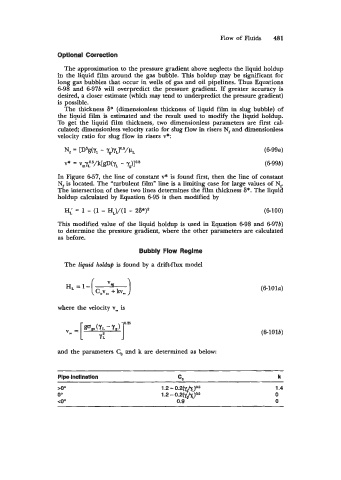Page 525 - Standard Handbook Petroleum Natural Gas Engineering VOLUME2
P. 525
Flow of Fluids 481
Optlonal Correction
The approximation to the pressure gradient above neglects the liquid holdup
in the liquid film around the gas bubble. This holdup may be significant for
long gas bubbles that occur in wells of gas and oil pipelines. Thus Equations
6-98 and 6-976 will overpredict the pressure gradient. If greater accuracy is
desired, a closer estimate (which may tend to underpredict the pressure gradient)
is possible.
The thickness 6" (dimensionless thickness of liquid film in slug bubble) of
the liquid film is estimated and the result used to modify the liquid holdup.
To get the liquid film thickness, two dimensionless parameters are first cal-
culated; dimensionless velocity ratio for slug flow in risers Nf and dimensionless
velocity ratio for slug flow in risers v*:
N, = [DWY, - Y,>~,Io.~//c~, (6-99~)
v* = V,Yy/k[gD(Y, - (6-99b)
In Figure 6-57, the line of constant v* is found first, then the line of constant
N, is located. The "turbulent film" line is a limiting case for large values of Nr
The intersection of these two lines determines the film thickness 6". The liquid
holdup calculated by Equation 6-95 is then modified by
Hi = 1 - (1 - HL)/(l - 26*)' (6-100)
This modified value of the liquid holdup is used in Equation 6-98 and 6-976)
to determine the pressure gradient, where the other parameters are calculated
as before.
Bubbly Flow Reglrne
The liquid holdup is found by a drift-flux model
V )
HL=l-(
COV, + kv, (6-101 U)
where the velocity v_ is
(6-1016)
and the parameters C, and k are determined as below:
Plpe lncllnatlon co k
>O" i .2 - 0.2(~8~)0.5 1.4
0" i .2 - 0.2(~,4~~)a5 0
<0° 0.9 0

